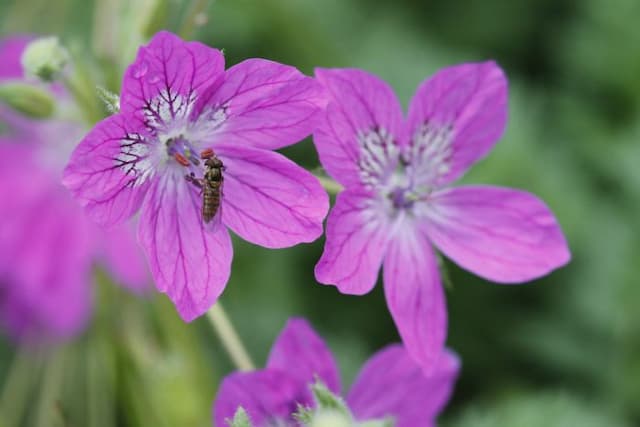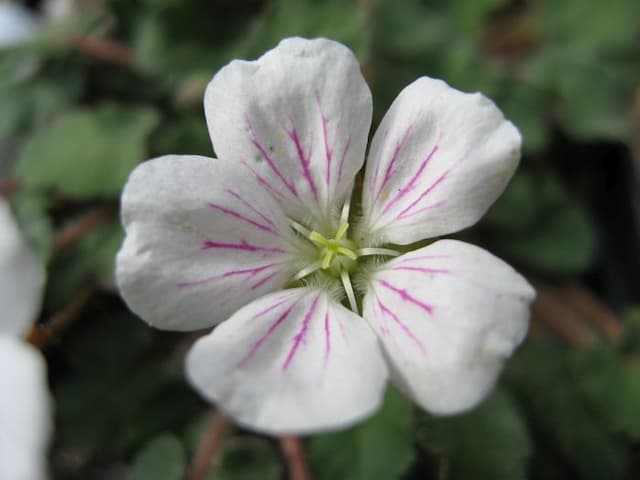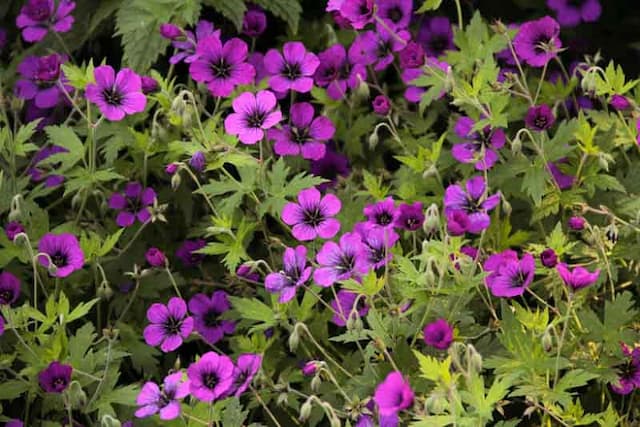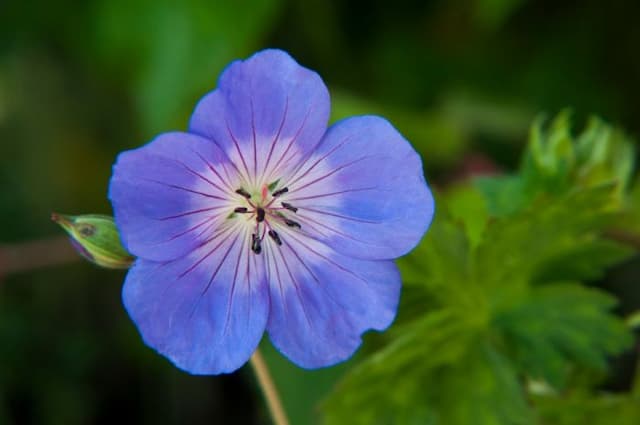Dusky Cranesbill Geranium phaeum 'Album'

ABOUT
Geranium phaeum 'Album', commonly known as dusky crane's-bill, is a perennial plant cherished for its distinctive floral and foliage characteristics. It features a bushy mound of deeply lobed, dark green leaves that often exhibit a unique maroon or purple tint in certain conditions, forming a rich and textured backdrop. Emerging from this attractive foliar base, the plant is adorned with elegant, cup-shaped flowers throughout late spring and into early summer. These blooms are a crisp, pure white in color, with a delicate structure that offers a soft contrast to the darker foliage. Each flower has a set of petals arranged symmetrically around a central core, where subtle stamens may be visible. The blooms are held aloft on thin, branching stems that rise above the leafy mass, creating an airy and enchanting display that can add brightness and lightness to any garden space. The dusky crane's-bill is a beloved addition to borders, woodland gardens, or as ground cover, particularly valued for the understated charm and serene color palette it brings to a garden's composition.
About this plant
 Names
NamesSynonyms
Mourning Widow, Dusky Cranesbill, Black Widow
Common names
Geranium phaeum 'Album'.
 Toxicity
ToxicityTo humans
Dusky cranesbill is generally considered non-toxic to humans, and there are no major concerns or reports of poisoning from ingestion of this plant by humans. However, as with any plant, individual allergies or sensitivities could potentially occur, so it is still advised to avoid eating this or any other plant not specifically grown for consumption.
To pets
Dusky cranesbill is also generally considered non-toxic to pets, including cats and dogs. There should be little to no risk of poisoning if pets happen to ingest parts of this plant. As with humans, pets can also have individual sensitivities, so monitoring for any unusual reactions after ingestion is still wise, but serious toxic consequences are not typically expected.
 Characteristics
CharacteristicsLife cycle
Perennials
Foliage type
Deciduous
Color of leaves
Green
Flower color
White
Height
2 feet (60 cm)
Spread
1 feet (30 cm)
Plant type
Herb
Hardiness zones
4
Native area
Europe
Benefits
 General Benefits
General Benefits- Attracts pollinators: Geranium phaeum 'Album', also known as Dusky Cranesbill, is effective in attracting bees and other beneficial insects to the garden.
- Low Maintenance: This plant is easy to care for, requiring minimal attention once established.
- Drought Tolerant: Once established, it can tolerate periods of dryness, making it suitable for xeriscaping.
- Shade Tolerant: It can thrive in partial shade, providing flexibility in garden design.
- Ground Cover: Its spreading habit makes it useful for covering bare spots and suppressing weeds.
- Long Blooming: The plant produces flowers for an extended period, offering visual interest throughout the growing season.
- Deer and Rabbit Resistant: It is less likely to be eaten by deer and rabbits, making it a good choice for areas with wildlife.
- Aesthetic Value: With its delicate white flowers and attractive foliage, it adds beauty to any garden space.
- Hardy: It is resilient and can survive in a range of climates and conditions.
 Medical Properties
Medical Properties- This plant is not used for medical purposes.
 Air-purifying Qualities
Air-purifying QualitiesThis plant is not specifically known for air purifying qualities.
 Other Uses
Other Uses- Dye production: Geranium phaeum 'Album', commonly known as dusky cranesbill, can be used to produce a natural dye from its petals, suitable for coloring fabrics or crafts.
- Photography: The striking white flowers of the dusky cranesbill can provide an excellent contrast in macro photography and garden portfolios due to their delicate appearance.
- Garden design: Its clumping growth habit and shade tolerance make it an excellent ground cover or border plant in woodland garden designs.
- Erosion control: The dense growth of dusky cranesbill can help stabilize soil on slopes or in areas susceptible to erosion.
- Companion planting: When planted alongside vegetables, dusky cranesbill can attract beneficial insects that help to pollinate plants and control pests.
- Wildlife habitat: It provides cover and foraging grounds for beneficial insects, such as bees and butterflies, enhancing biodiversity.
- Education: It can be used as a tool for botany education, illustrating plant growth and reproduction cycles.
- Culinary decoration: Although not commonly consumed, the petals can be used for decorative purposes on cakes or dishes, after ensuring they are free from pesticides.
- Art inspiration: Artists can take inspiration from the dusky cranesbill’s form and color for botanical illustrations and nature-inspired artwork.
- Mood enhancement: Being around plants like dusky cranesbill has been linked to improved moods; growing them in personal spaces could therefore contribute to emotional well-being.
Interesting Facts
 Feng Shui
Feng ShuiThe Geranium is not used in Feng Shui practice.
 Zodiac Sign Compitability
Zodiac Sign CompitabilityThe Geranium is not used in astrology practice.
 Plant Symbolism
Plant Symbolism- Unexpected Meeting: Geraniums, in general, are often associated with encounters and meetings, suggesting that the 'Album' variety may represent a surprise or chance meeting.
- True Friendship: Geraniums have been linked to true friendship, signifying that the giver holds the receiver in high regard as a loyal and honest friend.
- Ingenuity: The geranium symbolizes cleverness or ingenuity, celebrating the plant's adaptable nature in various growing conditions and the resourcefulness it represents.
- Good Health: Traditionally, the geranium plant has signified good health, making it an ideal gift for those who are recovering from an illness or for wishing someone a healthy life.
- Happiness: The bright and cheerful appearance of geraniums radiates positivity, thereby symbolizing happiness and uplifted spirits.
- Folly or Stupidity: In some mythologies, geraniums also represent foolishness or stupidity, warning against thoughtless decisions or pointing out naiveté.
 Water
WaterThe dusky cranesbill, commonly known as Geranium phaeum 'Album', should be watered regularly to keep the soil consistently moist but not waterlogged. During the growing season, water the plant deeply once a week with about one gallon of water. Adjust watering frequency based on weather conditions, watering more often during hot, dry spells, and less during cooler, rainy periods. Overwintered plants require less water, so reduce watering to every other week. Ensure that the plant has well-draining soil to prevent root rot from excess moisture.
 Light
LightDusky cranesbill thrives in partial to full shade conditions. It is best to place the plant in a spot where it will receive filtered sunlight or only a few hours of direct morning sun, with shade during the intense afternoon heat. This light setup helps to avoid leaf scorch while providing enough light for healthy growth.
 Temperature
TemperatureDusky cranesbill performs well in a range of temperatures, generally between 60°F and 75°F. It can survive minimum temperatures down to about 50°F but should be protected from hard frosts and extreme heat over 85°F. The ideal temperature for this plant is a comfortably cool environment that mimics its natural woodland habitat.
 Pruning
PruningPruning the dusky cranesbill encourages a fresh flush of foliage and may promote a second bloom. Prune back the old flower stems and any dead or yellowing leaves in early to mid-summer, after the first bloom has finished. Deadheading spent flowers will also improve the plant's appearance. The best time for major pruning is late winter or early spring, just before new growth commences.
 Cleaning
CleaningAs needed
 Soil
SoilDusky Cranesbill, commonly known as Geranium phaeum 'Album', thrives in moist, well-draining soil rich in organic matter with a pH range of 5.5 to 7.0. A mix consisting of garden soil, peat or compost, and gritty material like perlite or sand is ideal, ensuring nutrients and proper aeration.
 Repotting
RepottingDusky Cranesbill doesn't require frequent repotting; it should be repotted every 2-3 years if grown in a container. This helps to refresh the soil and accommodate root growth, but they are generally content to remain in the same spot if they're not outgrowing their current container.
 Humidity & Misting
Humidity & MistingDusky Cranesbill doesn't have specific humidity requirements; it is adaptable to a wide range of humidity levels typical of most indoor environments making it suitable to grow in average room conditions.
 Suitable locations
Suitable locationsIndoor
Place in bright, indirect light with moist soil.
Outdoor
Choose partially shaded spot with moist, fertile soil.
Hardiness zone
4-8 USDA
 Life cycle
Life cycleGeranium phaeum 'Album', commonly known as Dusky Cranesbill, begins its life cycle as a seed, which upon germinating in suitable conditions, sprouts into a seedling. As the plant matures, it develops a rosette of deeply lobed leaves and begins to form sturdy stems. In late spring to early summer, it enters its flowering stage, producing white flowers with prominent veining, which attract pollinators and promote cross-pollination. After flowering, it sets seed, which are dispersed by various means, sometimes assisted by the attractive, beak-like seed pods that give the cranesbill its common name. These seeds will lie dormant until the following spring or until conditions are right for germination, completing the cycle. Throughout its life, perennial phases of growth sustain the plant, allowing for it to die back in winter and re-emerge from its robust rootstock with each new growing season.
 Propogation
PropogationPropogation time
Early spring
The Geranium phaeum 'Album', commonly known as the white mourning widow or dusky cranesbill, can be propagated most effectively by division, which is best done in the spring or autumn. To propagate by division, carefully dig up the plant and gently separate it into smaller sections, ensuring that each section has a portion of the root system. Replant these divisions at the same depth they were growing previously, spacing them about 12 inches (approximately 30 cm) apart to allow for ample growth. Water the new plantings thoroughly to help establish them. This method quickly multiplies the plants and helps rejuvenate older clumps that may have become woody or overgrown, promoting more vigorous growth and flowering.









![Cranesbill [Rothbury Gem]](/_next/image?url=https%3A%2F%2Fplants-admin.emdemapps.com%2Fimages%2Fplants%2F%2Fimages%2F604b6243984c2.png&w=640&q=75)